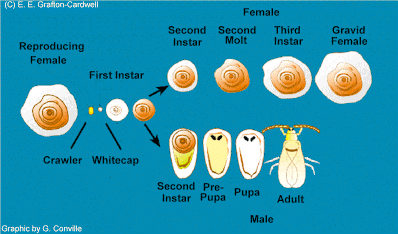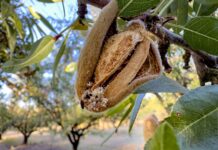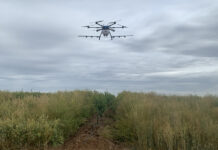This soft scale citrus pest has not been found in significant numbers in the San Joaquin Valley for the past several years, but cooler and wetter weather in April could mean a higher infestation rate this year. Mild weather maximizes egg hatch and helps nymphs survive.
Dr. Beth Grafton Cardwell, director of the Lindcove Research Center and research entomologist at UC Riverside, presented information about citricola scale in a webinar for growers and pest control advisors.
Control of citricola scale is a numbers game, Grafton-Cardwell said. Not letting populations get large before taking action is important. Damage thresholds are low and citricola scale numbers can expand quickly under the right conditions. Severe infestations in citrus can reduce tree vigor, flowering and fruit set. Citricola also excretes honeydew and sooty mold accumulates, interfering with photosynthesis.
High numbers of scale observed in the spring can have a negative effect on the next year’s yield.
Citricola scale produces one generation per year. Eggs, first instar nymphs, second instar nymphs and adult females are present at different times of the year.
Citricola scale females lay more than 1,000 eggs from early May to August. Crawlers emerge after two to three days and move to the underside of leaves. These flat, and almost translucent scales molt once and by November turn a darker color and begin migrating to twigs late winter and early spring, maturing to adults by late April.

The best time to treat scale infestations is late July to early August when the scales have hatched and moved onto leaves. They are vulnerable to pesticide treatments, heat and some parasitoids.
Identification of the scale condition is important in the monitoring process. Only healthy scale are counted. To sample for scale, collect leaves from northeast corner of the tree, choosing leaves that are shaded. One leaf per tree should be collected down the row until 25 leaves are collected. Leaves infested with live scale are counted and the procedure repeated in four evenly spaced rows in the orchard.
The decision to treat is based on numbers. A count of more than 12 infested leaves per row warrants a treatment. Treatment will be most effective when crawlers move out onto leaves. Coverage is critical because insecticide must contact the crawlers. Slower spray speed is advised. The neonicotinoids Assail and Sivanto are most effective, but continued use of products from that group will allow resistance to develop. Insect growth regulator buprofezin will suppress citricola scale during the season it is applied.
The UC IPM guidelines report that about 40 percent of the citricola scale populations in the San Joaquin Valley have developed resistance to organophosphate insecticides























